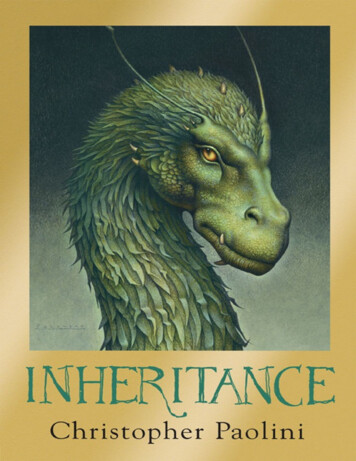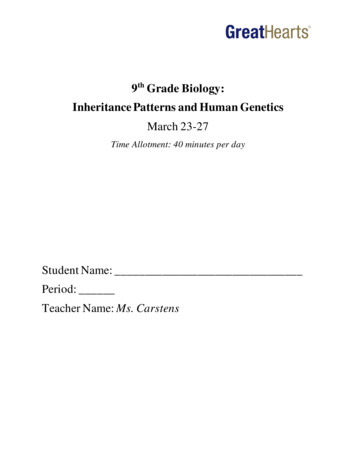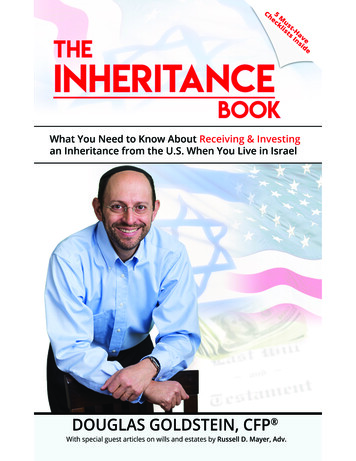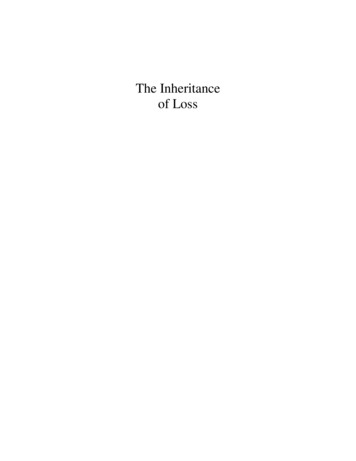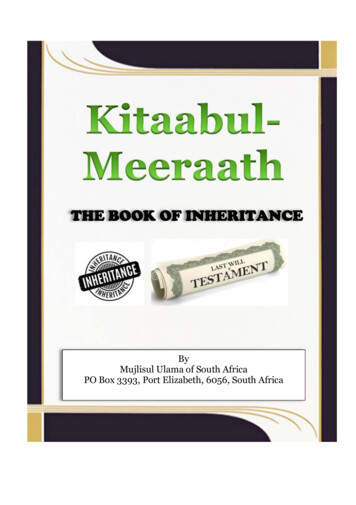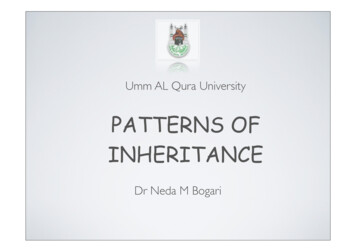
Transcription
Umm AL Qura UniversityPATTERNS OFINHERITANCEDr Neda M Bogari
PATTERNS OFINHERITANCE Definition Family Studies Pedigree drawing and Terminology Mendelian inheritance Non-Mendelian inheritance Mitochondrial inheritance
PATTERNS OF INHERITANCE:DEFINITION Its the manner in which a particular genetictrait or disorder is passed from one generationto the next. Examples: Autosomal dominant, autosomal recessive, X-linked dominant, X-linked recessive, multifactorail, and mitochondrial inheritance.
PATTERNS OFINHERITANCE The importance of studying the pattern ofinheritance of disorders within families:– Genetic counseling: Advice to be given tomembers of a family regarding thesusceptibility of their developing the diseaseOR.– Passing it on to their children.
IMPORTANCEDEFINITION A pedigree is a chart of the genetic history offamily over several generations.
Standard symbols for pedigrees.
IMPORTANCE DEFINITION Locus: The position of a gene on a chromosome. Allele: one of several alternative form of a geneat a given gene locus. Genotype: refers to an individual’s genes. Phenotype: refers to an individual’s physicalappearance. Heterozygous: having two different alleles at agiven gene locus. Homozygous: having identical alleles at a givengene locus.
Genotype the gene types a person inherited
Phenotype the physical (& behavioral)characteristics an individual displays
AllelesQuiet! I’ll speakfor both of us!Dominant NormalAlleleAlleleI’ll have to bein charge now!Recessive DamagedAlleleAllele
MENDELIAN DISORDERS Austrian botanist GregorMendel (1822-84) More than 11,000Mendelian (monogenic)disorders have beenrevealed OMIM (Online MendelianInheritance in Man)database
MENDELIANINHERITANCEAutosomal inheritance: Dominant. Recessive.Sex-linked inheritance: Dominant. Recessive.
Autosomal InheritanceQuiet! I’ll speakfor both of us!Dominant NormalAllele AlleleI’ll have to bein chargenow!RecessiveDamagedAllele Allele
AUTOSOMAL DOMINANTINHERITANCE Both male and female are affected The disease is observe in multiple generations Transmission of the disease can be from both sexes Mutation in only one allele is enough to express thedisease Vertical transmission The offspring have 50% chance to have the disease
AUTOSOMAL alSonNormalMotherAffectedSonNormalDaughter
Punnett s square showing possiblegamete combinations for anautosomal dominant allelewwWWwWwwwwww
AUTOSOMAL DOMINANTDISORDERS Huntington disease Autosomal dominant Gene in chromosome 4p Adult onset of the disease Choreic movement disorder Mood disturbance Progressive loss of mentalactivity
AUTOSOMAL DOMINANTDISORDER Marfan Syndrome Autosomal dominant Gene in chromosome 15q(Fibrillin) Connective tissue disorderwith characteristic skeletal,dermatological, cardiac,aortic, ocular and duralmalformations.
AUTOSOMAL DOMINANTDISORDERAchondroplasia is autosomal dominant geneticdisorder that is a common cause of dwarfism
Most Cancer Susceptibility Genes AreDominant With Incomplete PenetranceNormalSusceptible CarrierCarrier, affectedwith cancerSporadic cancer Penetrance is often incomplete May appear to “skip” generations Individuals inherit altered cancer susceptibility gene,not cancer
Factors Affecting PenetranceModifiergenesResponse to t everyone with an altered gene develops cancer
AUTOSOMAL DOMINANTDISORDERS Variable expressivity: some individuals show moreaggressive form of the disease while othershowed a milder form of the disease. Reduced penetrance: is term used to indicatethat the disease some time to presenting noabnormal clinical feature New mutation Codominance: the presence of two alleles inheterozygous state (e.g. AB blood group)
AUTOSOMAL RECESSIVE INHERITANCE Both male and female are affected The disease is observe in only singlegeneration Both gene alleles (Heterozygous)need to be affected in order toexpress the disease
Autosomal Recessive aughterCarrierMotherCarrierSon50% chance carrierAffectedDaughter25%affected
Punnet s square showing possible gametecombinations for an autosomal recessivealleleaAAAaAAaaaaA
Autosomal Recessive InheritanceNoncarrier individualNon-affected carrierAffected individualTwo germline mutations (one from each parent)to develop disease Equally transmitted by men and women
Families with individuals expressingautosomal recessive phenotypes.
AUTOSOMAL RECESSIVE INHERITANCE Consanguinity Pseudodominance is an autosomal recessivecondition appears in subsequent generations andso therefore appears to follow an autosomaldominant pattern. Locus heterogeneity: A single disorder, trait, orpattern of traits caused by mutations in genes atdifferent chromosomal loci.
Genetic HeterogeneityChr 17Chr 13Mutations indifferentgenes cancause thesame diseaseBRCA1BRCA2Hereditary breast and ovarian cancer
Different mutations in the same gene can produce awide range of effects. In cystic fibrosis, forinstance, the gene that controls mucus productioncan have more than 300 different mutations; somecause severe symptoms; some, mild symptoms; andsome, no symptoms at all.
Autosomal Recessive disorder Galactosemia An infant is unable tometabolize galactose Damage of the liver,central nervous system andvarious other body systems An infant may developjaundice, vomiting,lethargy, irritability andconvulsions
Autosomal Recessive disorder Cystic fibrosis (CF) Gene localized atchromosome 7q Affected childrenhave chronicrespiratory infection,and malabsorpition
SEX-LINKEDINHERITANCE X-linked dominant X-linked recessive Y-linked
X-LINKED DOMINANTINHERITANCE Mutations only in X chromosome Both males and females are affected Affected males transmit the disease to theirdaughters (male to female only) Affected females transmit the disease to daughtersand sons
X-LINKED DOMINANTINHERITANCE
X-LINKED DOMINANTINHERITANCE– More females than males– All daughters of affected males are affected, but no sons– A child of an affected female has 50% risk of disease
X-LINKED RECESSIVEINHERITANCE Mutations only in X chromosome Only males are affected Transmission through unaffectedfemales to male No male to male transmission
X-LINKED RECESSIVEINHERITANCE
X-LINKED RECESSIVEINHERITANCE– Affects almost exclusively men– Affected men born from carrier mother, with 50% risk of disease– No male to male transmission
X-LINKED RECESSIVEDISORDER Duchenne musculardystrophy (DMD) Affected gene onchromosome Xp21 Progressive weaknessand muscle wasting
Y-LINKED INHERITANCE Only males areaffected Male infertility
Y-LINKED INHERITANCE (Y)– Affects only males– Affected males always have affected fathers– All sons of an affected male are affected
Y-linked gene (feature)Hairy earsOnly males are affected
MITOCHONDRIALINHERITANCE All mitochondrialDNA is maternallyinherited Mitochondrialdiseases s
PATTERNS OF INHERITANCE: DEFINITION Its the manner in which a particular genetic trait or disorder is passed from one generation to the next. Examples: Autosomal dominant, autosomal recessive, X-linked dominant, X-linked recessive, multifactorail, and mitochondrial inheritance.

